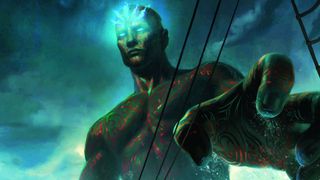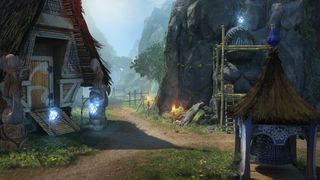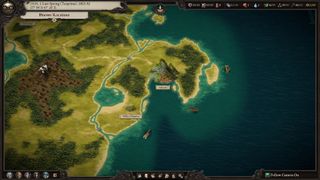Pillars of Eternity 2 dev talks worldbuilding, and making all that text 'easier to digest'
Narrative co-lead Carrie Patel explains the lessons learned from Pillars of Eternity, and what's new in Deadfire.

Pillars of Eternity 2: Deadfire has big boots to fill when it releases next month, and will be bringing old and new tricks to the party-based RPG format of the highly-acclaimed Pillars of Eternity. Earlier this month at PAX East, narrative designer Carrie Patel explained how Deadfire plans to fold in the lessons learned from Pillars of Eternity, as well as from Tyranny, with tooltips, an expanded reputation system, and less-imposing blocks of text—without sacrificing the breadth of information classic-style RPGs like Pillars are known for.
The demo that Obsidian offered on the show floor at PAX is the same one that Andy wrote about playing in March. With Patel open to a bit of interrogation, I was able to find out more about how Tikawara became the chosen testing ground, how the team designed the demo's grass hut villages and bamboo forests, and Patel’s plans for her returning player companion: Aloth Corfiser.
Setting the scene
Tikawara was designed specifically to make sure that every system in Deadfire could be seen during the course of the demo. As Andy’s earlier adventure highlights, there are hints of a brewing conflict and the protagonist’s ability to get squarely in the center of it, some classic dungeon-crawling, and opportunities to try out the brand new ship combat system while sailing between the demo’s two islands.
“Story-wise, we wanted to get some of those conflicts and concerns in. We're always big on giving the player interesting choices that are not purely black and white. Letting the player choose how to resolve the tribe's concerns about the Adra and the possibility of Vailian colonization and showing two different viewpoints about what that might look like for them and letting the player decide.”
Whenever we're worldbuilding it can be useful to pull from real world influences but you never want to be like, ‘Oh, I'm just making a fantasy version of this existing culture.’
Carrie Patel
When it comes to the day-to-day work of building a place like Tikawara, Patel explains that Obsidian’s team of area designers and narrative designers are matched up to build the space both physically and culturally. “It's our job as narrative designers to come up with good stories and make sure those are expressed in the game, but it's also something the area designers are intimately involved with. They're designing the levels, the quests, and the gameplay so we sit down early on in the concept stage and hash out what the area's going to be, where it fits in with the game, what kind of gameplay they're trying to implement, what kind of story we want to bring in and how to marry those two interests.”
Patel goes on to explain that area designers frequently take the lead on documentation by writing out what the area will be like and what kind of quests will be available. Afterwards, area designers and narrative designers like Carrie sit down together to get on the same page before a narrative designer gets to work on the actual dialogue and descriptions.
“So the area designer will set up a greybox blockout of the level and they'll also put together a stub of our dialogue. It's a very stripped-down version with the scripting in just to make the content progress-able and also put in a very basic form the required information and the basic structure of the dialogue. Then the narrative designer will take that stub and will actually write the dialogue. They'll develop the character, give it some flow and pacing and make it that fun experience we all like to have when we're talking to an NPC.”
The biggest gaming news, reviews and hardware deals
Keep up to date with the most important stories and the best deals, as picked by the PC Gamer team.

Unlike the original Pillars of Eternity, which made itself comfortable in a cocoon of classic high fantasy forests and historical European design, Deadfire presents a setting full of new influences. I asked Patel how narrative and area designers collaborate to create a culture, both in the characters and the look of the world.
“Whenever we're worldbuilding it can be useful to pull from real world influences but you never want to be like, ‘Oh, I'm just making a fantasy version of this existing culture.’," she said. "Both in the aesthetics and the visual design and also in the history and the story of these different cultures. We find inspiration in real life but we also innovate and imagine.” Patel references Maori and Polynesian influences, but her caveat suggests that Deadfire will create more than it borrows.
Reputation management
The Deadfire Archipelago is rich in resources, an obvious point of contention for the locals and outsiders. “It's not just the Vailians and the Huana of course, it's also the Rauataians and the pirate nation Príncipi sen Patrena who are all vying for control. They all have different things that they want out of Deadfire and so the question is really, 'Who is going to control Deadfire and what do they want to make of it?'”
The player’s reputation with each faction will take a much greater role in Deadfire than faction relationships did in the first Pillars game. Patel mentions how localized the factions in Pillars were and how Deadfire’s factions will be a more constant presence.
“So you could have a faction for the city of Neketaka. How do people know you there? Are you known for doing a lot of good things or are you known for being a rascal? You also have a reputation with the Huana at large so the things you do for the Huana in Neketaka and the things you do for the Huana in Port Maje, those will both feed in to your overall reputation.”

Familiar faces
In an admittedly left-turn, I asked Patel to tell me about the companion character she's in charge of, Aloth. High-level story crafting is always fascinating but individual characters are the true pet projects of many writers and Patel has a plan for hers. Without getting into the spoilers from Pillars of Eternity that we discussed, Patel explains that at the end of Aloth’s series of quests in Pillars he can be guided by the protagonist to pursue two possible paths related to his organization.
“So in this game when the player meets him, he's about five years into whichever project you sent him on. In the first game Aloth has a lot of questions about authority and who he should follow and where to get his sense of direction. In the second game, I wanted to give him concerns and questions that were obviously not the ones you already answered in the first game, but that would feel like a continuation of his story.
He's realizing that whichever path he took, his task is a lot more complicated and morally fraught that he thought, and that sometimes doing the right thing isn't always as easy as he thought and that the things he does don't always turn out the way he hoped. So he's kind of dealing with some conflict as to how to be effective in a very complex role and what his obligations are and whether he's responsible for the things he accidentally sets in motion.”

Modernizing the classics
Also returning for Deadfire is Aloth’s voice actor from Eternity, Matthew Mercer. Mercer currently serves as the Dungeon Master for the popular tabletop web series Critical Role. On April 10th, Obsidian announced that Mercer will be joined by the rest of the Critical Role cast in Deadfire. According to the announcement, each will be reprising their own character from Critical Role's first tabletop campaign in the form of voice set options. Patel says each member will be voicing “key roles” (critical, you might say), both companions and other characters.
Even after the success of the first Pillars of Eternity, Obsidian hasn’t stopped looking for places to improve. In the writing team, Patel highlights the at times overwhelming prose of Pillars 1: "Compared to the first game, we've made a conscious effort to—I think for some people just the presentation of text in the first Pillars was a bit heavy—so we made an effort to pare down a lot of our dialogue nodes so we may convey the same amount of information, but know that it's going to be split between two or three so it's just easier to digest."
They’re also bringing in the tooltips system that Obsidian used in Tyranny to help remind players of important lore information without loading down dialogue itself with repeated references. “Another big thing is we have more tooltips now so you can hover over specific words and names and it will give you the definition and tell you what those mean. Just so we don't have to build that into the dialogue.”
Patel and the rest of the team are conscious of their spot at the forefront of what I’ve been viewing as an RPG renaissance. After Pillars of Eternity blew its funding goal out of the water, proving that the classic isometric RPG still has an enthusiastic audience, Obsidian found itself in the position of setting precedents.
“I think Obsidian feels a lot of pride and ownership about the renaissance as you call it," said Patel. "A lot of the people in our company also worked on some of the originals like Icewind Dale and Baldur's Gate so I think there's definitely a sense of continuity there and a sense of trying to bring back the things that really worked and made those games so wonderful, but still innovate and bring them into the modern era as well.”

Lauren has been writing for PC Gamer since she went hunting for the cryptid Dark Souls fashion police in 2017. She accepted her role as Associate Editor in 2021, now serving as self-appointed chief cozy games and farmlife sim enjoyer. Her career originally began in game development and she remains fascinated by how games tick in the modding and speedrunning scenes. She likes long fantasy books, longer RPGs, can't stop playing co-op survival crafting games, and has spent a number of hours she refuses to count building houses in The Sims games for over 20 years.
Most Popular
